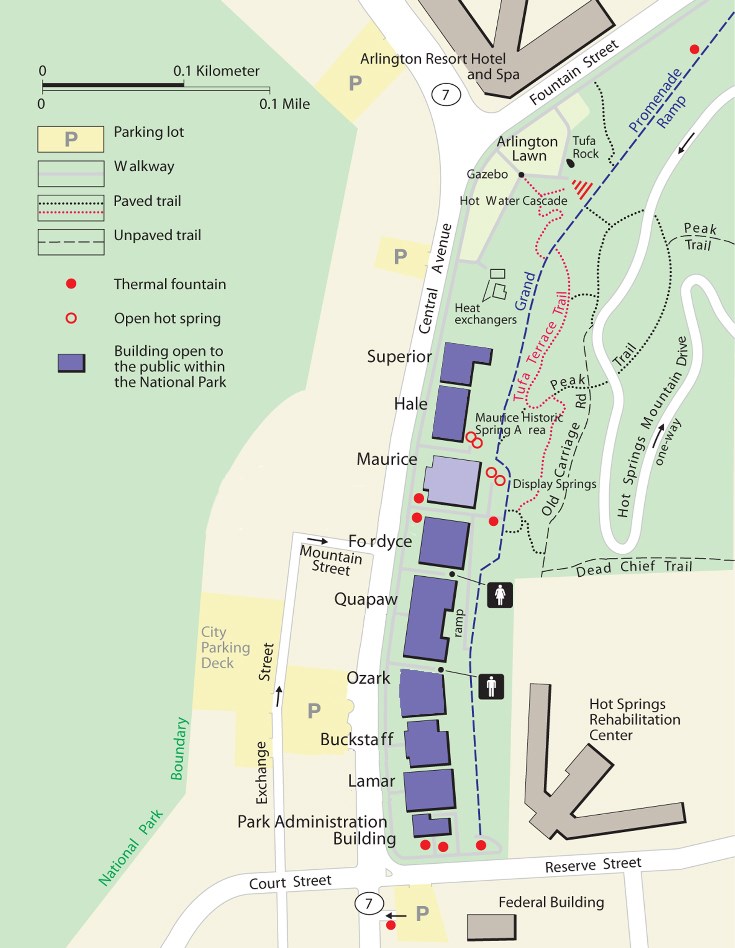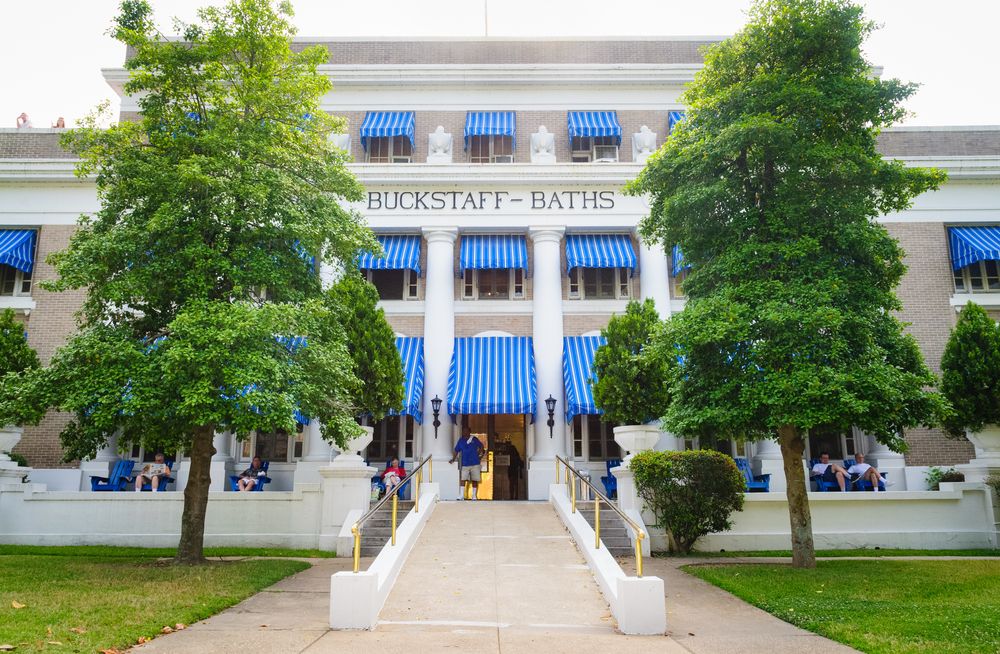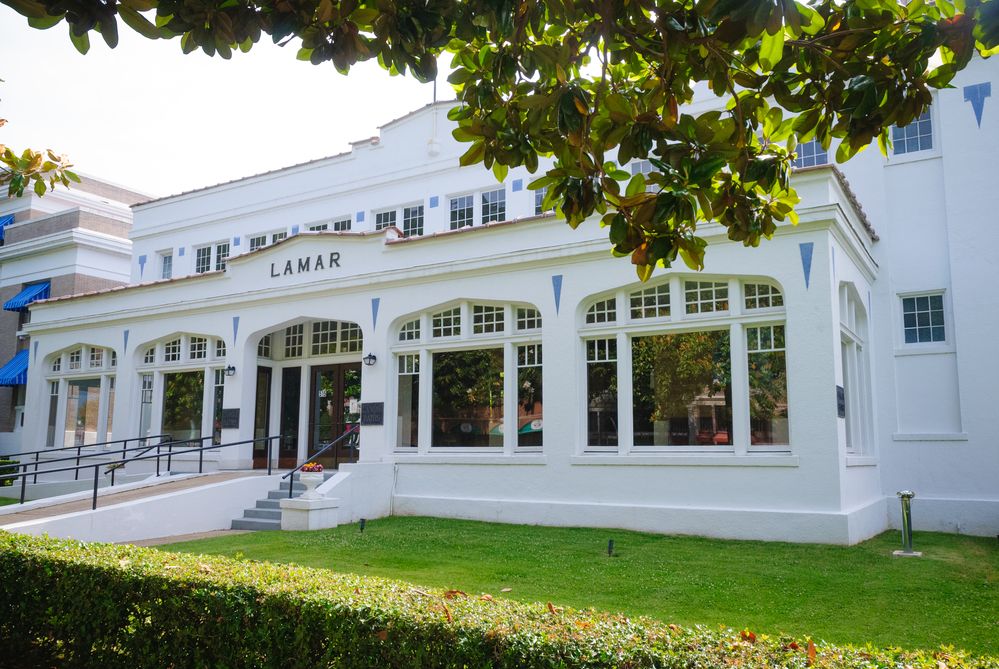Bathhouse Row is a National Historic Landmark District located in Hot Springs, Arkansas and Hot Springs National Park. It contains eight bathhouse buildings constructed between 1892 and 1923, including Superior, Hale, Maurice, Fordyce, Quapaw, Ozark, Buckstaff and Lamar. It also includes the Grand Promenade, a prominent brick path running parallel to Central Avenue and Bathhouse Row from Reserve Street to Fountain Street.

Superior Bathhouse
The first Superior Bathhouse was built on portions of the Hale and Big Iron sites. It was vastly different from its contemporary Victorian bathhouses, and it is said that it was named for offering superior service.
The modern version of the 11,000 square foot Superior Bathhouse was built by LC Young and Robert Proctor at a cost of $68,000. Architect Harry Schwebke designed it in an “electic commercial style of classical revival origin.” It was the smallest bathhouse on the Row and offered the lowest rates with basic hydrotherapy, mercury and massage services. It closed in 1983.
The Superior Bathhouse Brewery now occupies the building. It is the first brewery in a US national park and utilizes the thermal spring water as the main ingredient in the beer. The Superior Bathhouse building contains the brewery, craft beer tasting venue, restaurant and event venue.
Hale Bathhouse
Hale Bathhouse is named for John Hale and is the fourth building to take the name.
The current building is the oldest visible structure on Bathhouse Row. It was designed by George and Fremont Orff and completed in 1892. A major remodel was conducted by Mann and Stern in 1914 to enlarge the building and change it into the Classical Revival style. A second redesign was conducted in 1939 when the exterior of the building was covered in stucco. The building is 12,000 square feet on the two main floors. The Hale closed in 1978.
The building reopened in 1981 as a theatre, snack bar, gift shop and arcade. It was closed nine months later when the concession operator failed.
Little is known about the first building. After the Civil War, a second building was constructed on the present site with a bathhouse on the opposite side of the creek. The third was a Victorian style bathhouse built for $5000 sometime before 1882 by William Nelson.
The Hale Bathhouse is currently being transformed into a boutique hotel, with an expected open date in early 2019. The lease to reopen the bathhouse was signed in 2017. The hotel will be run by Pat and Ellen McCabe. Pat was also named the mayor of Hot Springs in 2017.
Maurice Bathhouse
Construction of the Maurice Bathhouse began in 1911 and it opened for business in 1912. It was designed by George Gleim, Jr. of Chicago and contained a total of 23,000 square feet in the three story bathhouse. The bathhouse was the only on Bathhouse Row to contain a pool (a therapeutic pool located in the basement). It also had a gymnasium, staterooms, twin elevators and a roof garden. It closed in 1974.
The Maurice Batthouse replaced the Victorian style Independent Bathhouse, which was renamed the Maurice Bathhouse after William’s father Charles Maurice.
The building is the only unoccupied one left on Bathhouse Row.
Fordyce Bathhouse
The Fordyce Bathhouse operated from 1915 to 1962 and was considered one of the best bathhouses in Hot Springs. It was the largest on Bathhouse Row with three main floors, courtyards and a basement – totaling approximately 28,000 feet. It reopened in 1989 as the Hot Springs National Park visitor center.
Quapaw Bathhouse
The Quapaw Bathhouse opened in 1922 and replaced the Horseshoe and Magnesia bathhouses. It is named for an American Indian tribe that once lived in the area and is built in the Spanish Colonia Revival style. It closed briefly in 1968 before being reopened and then closing again in 1984.
It is operated now as Quapaw Baths & Spa, which is a family oriented spa opened in 2008.
Ozark Bathhouse
The Ozark was finished in 1922 at a cost of $93,000. It was designed by Mann and Stern of Little Rock in the Spanish Colonial style. The Ozark catered to the middle class, with 27 tubs and only 14,000 square feet. It closed in 1977.
The Ozark reopened as a Cultural Center in 2014 and is operated by the Friends of Hot Sprigns National Park. It contains a gallery space for artwork from the Artist-in-Residence Program and other temporary exhibits. It is open on Friday, Saturday, and SUnday afternoons with free admission.
Buckstaff Bathhouse
It is the only remaining continuously operated thermal bathing facility – in operation since 1912. It offers mineral baths, hot packs, sitz baths, steam cabinets and Swedish Massages. It is open from Monday through Saturday with hours that vary by season. It is closed on Christmas Day, New Years Day, Easter Sunday, 4th of July and Thanksgiving Day. Reservations are not available.

There has been a bathhouse sitting on this site since the late 1850s, when a brick bathhouse was operated here. The A.B. Gaines bathhouse was the second here, operating until it was destroyed in an 1878 fire. The Rammelsberg Bath House was a Victorian frame batthouse erected here in the 1880s. It was operated by Harry Rammelsberg until 1898, when the lease ended and it was taken over in 1899 by George Buckstaff. There were 21 baths and it cost $3. It was leveled in 1912 when the Buckstaff batthouse was built in its place.
Lamar Bathhouse
Lamar now contains the park store, sponsored by Eastern National, called Bathhouse Row Emporium. The build also has the park archives, the Resources Management Employees, a storage space for the museum collection, and a small research library.

The Lamar Bathhouse opened in 1888 and was named for U.S. Supreme Court Justice Lucius Quintus Cincinnatus Lamar, who was Secretary of the Interior at the time. The current version of the bathhouse opened on 1923 and closed in 1985.
The structure was built in the early 1920s and cost $130,000. It was designed by Harry Schwebke and has a Spanic flavor with stone, brick and stucco construction. The lobby is the largest of the eight bathhouses and has a long counter of Tennessee marble.
The bathhouse was known for having a range of tub lengths from 5 feet to 6 feet, 6 inches to accommodate people of various heights. There was also a small coed gymnasium along with a separate women’s area next to the gymnasium.